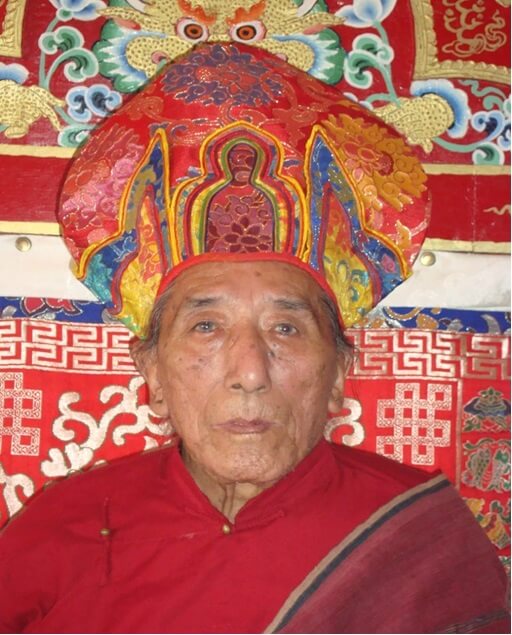Most Venerable Khamtul Jigme Thinley Lhundup Rinpoche

Khamtul Rinpoche was born in the year 1922 at Kham Dhakyab region of Eastern Tibet. At age six, he was recognized as reincarnation of TertonDorjeeDhakpa of Nyingma tradition and was trained in his monastery at a young age. He received many oral transmissions and empowerments like Kangyur, Rinchen Ter-zoed, Roldor Tso-Drak Kyi Ter-Choe, Choe-Tsok Yon-ten Kun-Jung and many other secret and profound teachings from renown Nyingma Masters in the eastern region of Tibet.
After receiving teachings from the masters in his region, Rinpoche went to Central Tibet where he received many precious teachings and empowerments from His Holiness Dudjom Rinpoche in Lhasa. His Holiness named him Khamtul Jigme ThinleyLhundupand imparted to him all the oral transmissions and empowerments of the TersarTroema tradition. He advised Rinpoche to adopt TersarTroema as his main practice and to uphold and promote the lineage. Rinpoche then travelled to all the major pilgrimage places in Kham and U-Tsang including Tsari in Southern Tibet where he established two nunneries. Rinpoche also received Kalachakra initiation from His Holiness Dalai Lama in Lhasa followed by oral transmission and empowerments of ChenrezigKhorwaThongdruk from His Holiness 16th Karmapa at Kham Dege.
Following the Chinese invasion, Rinpoche fled Tibet and arrived Arunachal Pradesh in 1959. There, Rinpoche soon became the leader of over 1000 refugees who had arrived in the area and were in desperate conditions. Rinpoche was heavily involved with the re-settlement of the refugees there acting not only as a spiritual leader but also as an administrative head and social worker. His efforts were well recognized by His Holiness the Dalai Lama who appointed him as his representative in the area. In the course ofhis compassionate activities, Rinpoche befriended many district administratorsand officials from the Central Government.


After several decades (?) of hard work at Arunachal Pradesh (District??) and with the refugees well settled, Rinpoche went to Nepal and eventually moved to the remote Yolmo (Helambu) region where he lived as a Yogi for many years. As in other places of his sojourn, Rinpoche established a small nunnery there with about a dozen nuns. Rinpoche often talked of his new refuge – ‘Surjiten’ – a beautiful place with majestic view of the mountains. Rinpoche spent most of his time there in contemplation and meditation. He was well loved by the local community who offered him and his nuns sustenance.



Because of political instability in Nepal and at special request of Taktse Ani Gonpa, in East Sikkim, Rinpoche left Nepal and moved there. Taktse Ani Gonpa is located about an hour north of Gangtok in a beautiful scenic land bestowed by the Chogyal of Sikkim. Rinpocheformally named the Taktse Ani Gonpa as OgyenDongagChoekhor Ling Nunnery and instituted the TersarTroema Chod practice there. Currently there are --- nuns at that nunnery with most of the nuns having completed their preliminary practice. Rinpoche also established a three-year retreat center there. To date - -- nuns have completed three-year, three-month retreat there. During his – year sojourn at the Taktse Ani Gonpa, Rinpoche lived in a small retreat cottage absorbed in meditation.



With the support of local sponsors, Rinpoche established yet another nunnery in Phenyong, Ranka, East Sikkim - about an hour’s drive outside Gangtok, the capital of Sikkim. Rinpoche named this monastery Khachoed Pema WoelingTsungon and formally inaugurated it in 2006. There also Rinpoche institutedDudjomTersarlineange and theTersarTroema Chod practice. Through the years Rinpoche continued to inspire his sponsors and devotees who worked to fulfill Rinpoche’s vision. Rinpoche greatly emphasized training of nuns in meditation practices. To this end he was persistent that a Tsamkhang (retreat center) be built for the nuns. Land for the retreat center was eventually secured and a Tsamkhang for three-year,three-month retreat of the nuns was completed in 2017 a few months after Rinpoche’s Parinirvana. Rinpoche also directed that a Stupa be built next to the nunnery. This was also accomplished in 2020 with H.E. JamyangKhyentse Rinpoche consecrating the Stupa.



To engage the local community of Ranka, Rinpoche instituted 2 major events annually – Bum Korand Nyungne. Bum Kor is a procession whereby monastics and lay people carry Kangyur – the Buddhist cannon and other collected works - through the fields and villages. Nyungne is a fasting retreat usually observed for a minimum of 3 days.
Bum Kor is observed usually on Drukpa Tse Shi, the 4th day of 6th month as per Tibetan calendar and commemorates the day when Lord Buddha turned the wheel of Dharma. The local community participates in the procession with some carrying scriptures and others lining up along roadside to receive blessings while others distribute water and soft drinks.


Nyungne – the 3 day fasting retreat is usually observed on Saga Dawa, the auspicious day commemorating Lord Buddha’s birth, enlightenment and Parinirvana. Local community actively participate in theNyungewith total no exceeding 100 persons. The villagers bring milk, vegetables and grains and alsohelp prepare food for the participants.


Rinpoche was a man of few words – a true Yogi who preferred to live a simple life in retreat steeped in meditation. He had few materialistic attachments and preferred the silence of the mountains. Rinpoche rarely visited his sponsors and refused many requests to visit countries abroad. And yet, Rinpoche could be very playful often telling stories of his adventures, poking fun of sponsors and constantly reminding them of impermanence.




After a brief illness Rinpoche passed into Parinirvana on 17th January 2016 at the ripe age of 94 years. Khenpo TenzingLhendup led the Anis into prayers for Rinpoche with Khenpo Zangpo Rinpoche, the founder of Samye Memorial Institute in Nepal presiding over the final funeral rites.
Khamtrul Rinpoche was a truly sublime being whose very presence relieved suffering His return as a reincarnate is fervently awaited so that his blessings may shower once again.



Under Khenpola’s leadership, Rinpoche’s first death anniversary was observed with the erection of a golden stupa where Rinpoche’s remains were kept. The nuns honored it by performing the ‘dakini’ dance.


